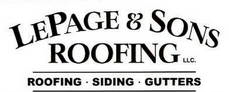If damage to your roof was caused by a storm, then your homeowners insurance should cover the cost of repairs. However, other causes of roof damage may not be covered. Damage as a result of general roof deterioration is one example.

LePage and Sons Roofing LLC, your trusted solar roofing contractor, explains more below.
Why Insurance Doesn’t Cover General Wear and Tear
Out of all the components found in your home’s exteriors, your roof usually has the biggest surface area exposed to natural elements. This means it’s subject to just about any type of weather condition throughout its lifespan. Routine maintenance checks and repairs can help delay your roof’s deterioration, but the fact is that continued exposure to the elements is an inevitable part of the system’s normal aging process. Depending on the type of climate you have in your local area, it can also affect your roof’s rate of deterioration over time.
When your roof starts to leak or suffer moisture problems due to wear and tear, your insurance policy won’t provide coverage for the repair costs. For insurance providers, the responsibility of caring for and maintaining the roofing system lies on you, the homeowner. When inspections and maintenance checks are overlooked, roof damage resulting from wear and tear is excluded from coverage.
Common Causes of Normal Wear and Tear
You won’t always be able to detect damage to your roof. Even if you do notice something unusual, it may not warrant an emergency roof repair. This doesn’t mean you can leave it as it is, however. You should still call an experienced roofing contractor to come inspect your system. It will be helpful to know the common causes of wear and tear, which include:
- Dark Spots – These are caused by roof granules falling off your roof. Roof granules provide a layer of protection to your roofing system. You can expect a small amount of granule shedding when your roof is first installed, and this is not a cause for concern. However, excessive loss of granules on an older roof is not normal and is a problem that requires immediate attention from your roofer. If the damage is isolated to a small area, it can be repaired, but otherwise you may need full roof replacement.
- Ultraviolet Rays – Direct sunlight can cause the colors of your shingles to fade over time. Insurance will not cover the cost of repairing this, although it’s generally not considered an urgent issue in any case. You’ll likely notice more faded colors on the south-facing side of your roof, which receives more direct sunlight throughout the day. Because of this, south-facing roofs tend to deteriorate at a much faster rate. If you find faded shingles throughout the rest of your roof, however, it may indicate that your roof is nearing the end of its lifespan. If this is the case, consider investing in a full replacement by a trusted contractor.
- Strong Winds – Strong wind can accelerate the wear and tear process on a roof. it can also lead to more significant roof damage depending on the situation. If your shingles are already cracked, a strong gust of wind can lift the edges off, further exposing the underlying roofing structure. Most roofing systems are built to withstand moderate to strong winds over time, but if this type of damage occurs during a storm, small debris can hit the shingles and cause cracks and gaps where moisture can seep through.
What Does Your Policy Cover?
Your homeowners’ insurance covers extensive repairs and replacement if your roofing system has suffered significant damage due to acts of nature. This can range from a tree falling on your home during a storm to wind-carried debris that hit your roof and left obvious cracks and dents on the roof surface. Such incidents may warrant emergency roof repair, but you should keep in mind that you’ll need to pay your policy deductible before the coverage kicks in.
Your insurance may also cover damage that must be repaired immediately to prevent further costs. This includes:
- Damaged/Missing Roof Materials – Whether it’s shingles or flashing, they must be repaired or replaced as soon as possible. If a recent thunderstorm left your roofing system in a bad condition, then you should be covered by your policy. Even if your shingles and flashing look intact, there could still be underlying damage, which should be covered as well. For instance, your roofing vents might have been badly damaged due to flying debris caused by a fierce windstorm. A band-aid solution won’t be enough to fix your roof. Your policy should cover the repair costs if it’s been determined after inspection that it was damaged by severe weather.
- Ice Damage – Snow storms can be brutal during the winter season, even to well-built roofs that have been properly cared for and maintained. If your roof has gone through a few of these recently, you need to have it inspected this spring. It may look intact, but could be harboring serious underlying damage. This can happen when snow from your roof melts and seeps through the layers. If this has been happening, it will likely refreeze after flowing down to the eaves. The cycle can repeat itself even as the season changes, eventually causing the wooden components of your roof to rot and leading to major leaks inside the home.
LePage and Sons Roofing LLC is a full-service roofing contractor proudly serving residential and commercial clients. Our team provides efficient and courteous service, making sure all roofing work is done to exacting standards. If you need roof replacement or repair, you can expect prompt, professional service and meticulous cleanup to ensure all you’re left with is a good-looking and durable roofing system.
Call us today at (508) 295-6483 or fill out our online contact form to request a consultation.
